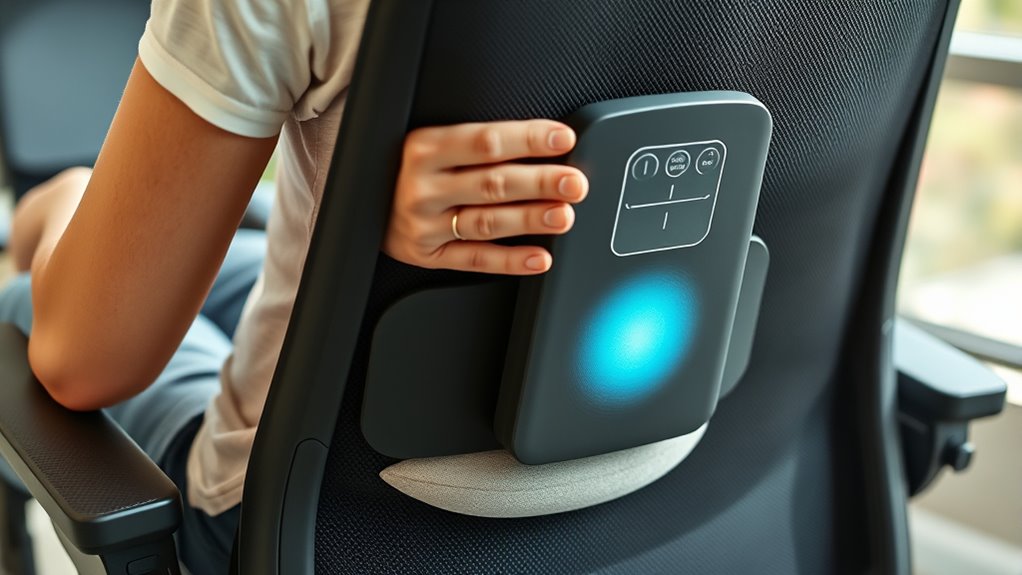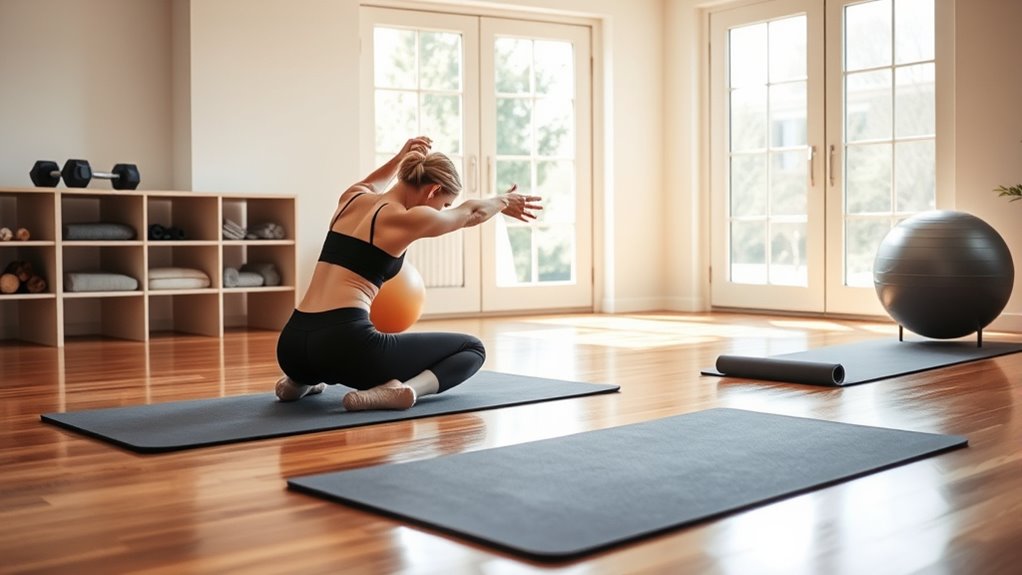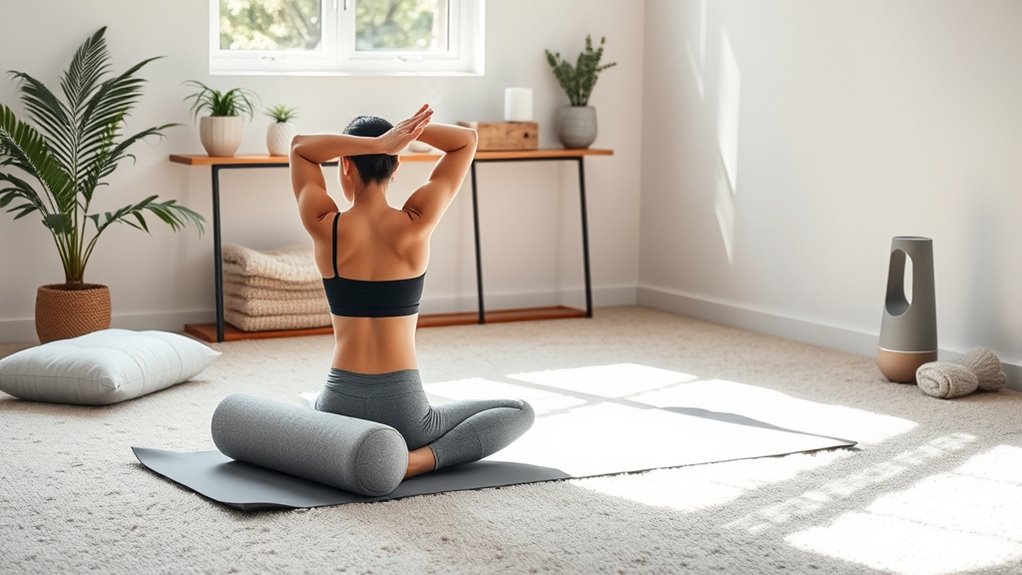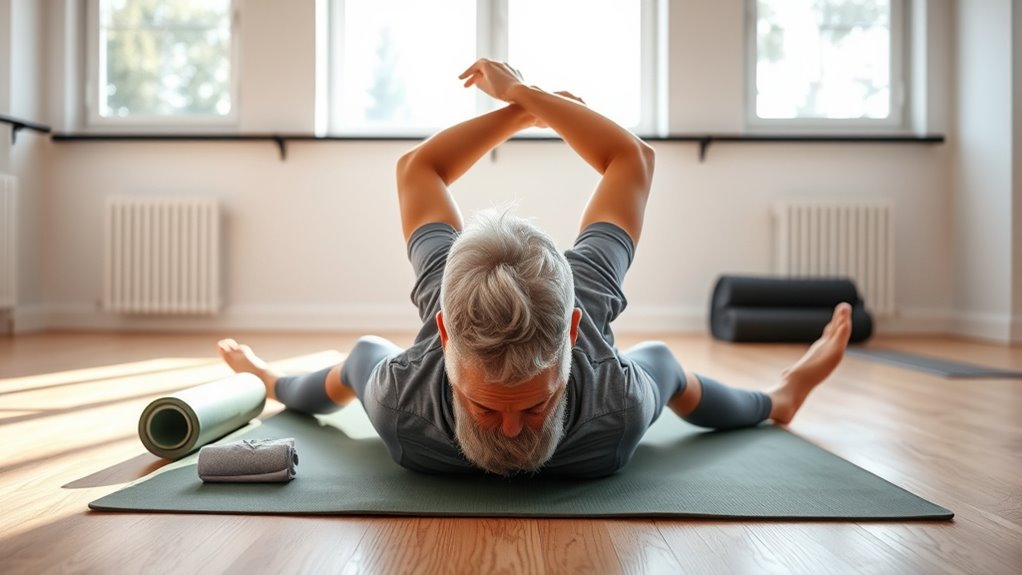To get the most out of your back pain exercises, focus on maintaining proper posture, alignment, and a safe environment. Start with gentle, low to moderate intensity, gradually increasing duration as your body adapts. Adjust equipment for comfort and support, and monitor pain levels closely to avoid overexertion. Incorporate rest and recovery tactics to support long-term health. Keep these tips in mind, and you’ll find the key steps to effective back pain relief and prevention.
Key Takeaways
- Maintain proper posture and spinal alignment during exercises to prevent strain and support back health.
- Start with low to moderate intensity, gradually increasing duration and complexity based on body response.
- Ensure a clutter-free, well-lit, and stable environment with ergonomic equipment for safety and proper form.
- Incorporate regular rest, gentle stretching, and hydration to promote recovery and prevent overexertion.
- Monitor pain levels closely, adjusting exercise intensity and technique to avoid aggravating back issues.
Understanding the Role of Proper Posture and Alignment

Proper posture and alignment are essential for preventing and alleviating back pain. When you maintain good posture, you support your spine’s natural curves, which helps preserve spinal flexibility. Proper alignment ensures that your muscles are balanced, reducing strain on specific areas and preventing muscle imbalances that can lead to pain. Focus on standing and sitting with your shoulders back, chest open, and pelvis in a neutral position. Avoid slouching or leaning forward, which can compromise spinal integrity. Incorporating awareness of muscle balancing through correct posture helps keep your back muscles evenly engaged and flexible. This foundation not only reduces discomfort but also prepares your body for safe, effective exercises that improve overall back health.
Selecting Appropriate Exercise Intensity and Duration

Choosing the right exercise intensity and duration is essential for safely strengthening your back without risking injury. You want to avoid pushing too hard or doing exercises for too long, which can cause setbacks. Focus on gradual progress with appropriate stretching techniques and breathing exercises to improve flexibility and relaxation. To find the right balance, keep these tips in mind:
- Start with low to moderate intensity, listening to your body’s signals
- Limit sessions to 10-15 minutes initially, then gradually increase
- Incorporate gentle stretching techniques to prevent stiffness
- Use controlled breathing exercises to enhance focus and reduce tension
Adjusting Equipment and Support Devices for Comfort

To guarantee your support devices provide maximum comfort, start by checking that your equipment fits properly. Choosing the right support depends on your specific needs, so consider options like braces or cushions carefully. Adjusting straps and padding can make a big difference in how comfortable and effective your devices are during exercises.
Proper Equipment Fit
Have you ever felt discomfort from ill-fitting equipment or support devices? Proper equipment fit is essential for back pain relief and exercise effectiveness. Start by ensuring your ergonomic chair supports your lower back and encourages good posture. When using a cushioned mat, make sure it’s thick enough to cushion pressure points without restricting movement. Adjust support devices so they don’t cause pinching or slipping. Check that your chair height allows your feet to rest flat on the floor. Keep support devices snug but not tight. Regularly reassess and modify your setup to prevent strain. Remember, a well-fitted chair and cushioned mats promote comfort, helping you stick to your exercise routine and minimize discomfort. Proper fit makes all the difference in back pain management.
Support Device Selection
Adjusting your support devices for comfort is essential to prevent strain and guarantee effective back pain relief. Properly fitted ergonomic chairs and support braces can make a significant difference in your exercises. Ensure your chair supports your lower back, keeps your feet flat on the ground, and maintains a neutral spine. Support braces should be snug but not tight, offering stability without restricting movement. Here’s a quick visualization:
| Device Type | Adjustment Tip | Comfort Indicator |
|---|---|---|
| Ergonomic Chair | Adjust lumbar support for curve | Feels supportive without pressure |
| Support Brace | Tighten so it stays in place | No slipping or pinching |
| Cushion/Pad | Place where needed for extra support | No discomfort or pressure points |
Comfort Adjustment Tips
Ensuring your support devices feel comfortable is key to maintaining proper back health during exercises. Proper adjustments help prevent strain and improve posture. Start by customizing your ergonomic cushions so they provide ideal lumbar support, reducing pressure on your lower back. Use adjustable chairs that allow you to set the seat height, backrest angle, and armrests for personalized comfort. Make sure your feet are flat on the ground and your knees are at a 90-degree angle. Regularly check and fine-tune these settings to stay comfortable throughout your workout. Remember, small adjustments can make a big difference in maintaining proper alignment and reducing discomfort during exercises. Stay attentive to your body’s signals and adapt your equipment accordingly.
Creating a Safe Environment for Home and Gym Workouts

To stay safe during your workouts, make sure you have a clear, clutter-free space to move freely. Set up your equipment properly to prevent strain or injury, and guarantee your surroundings are free of hazards. Creating a safe environment helps you focus on your exercises and protects your back.
Clear Workout Space
Creating a safe workout environment starts with clearing your space of obstacles and hazards. A clutter-free area helps prevent trips and falls during stretching routines or other exercises. Make certain the floor is clean, dry, and free of loose objects. Consider these key points:
- Remove loose cords or rugs that could cause slipping
- Keep your workout mat on a stable, even surface
- Place water nearby for hydration tips during breaks
- Make sure good lighting to monitor your movements
A tidy space encourages focus and reduces injury risk. Remember, staying hydrated is essential, especially during stretching routines. Clear, organized surroundings boost your confidence and safety, making your back pain exercises more effective. Prioritize a clean, hazard-free zone for best results.
Proper Equipment Setup
Setting up your equipment properly is essential for a safe and effective workout, whether at home or in the gym. Use ergonomic chairs to support good posture during warm-ups or seated exercises, reducing strain on your back. Ensure your foam rollers are sturdy and appropriately sized to target tight muscles and improve flexibility. Place foam rollers on a non-slip surface to prevent accidents. Check that your workout area has enough space to move freely and avoid obstacles that could cause falls. Keep equipment like resistance bands, weights, and mats organized and within reach. Proper setup minimizes injury risk and helps you maintain correct form throughout your exercises. Taking these steps creates a safe environment, so you can focus on strengthening your back effectively.
Safe Exercise Environment
A safe exercise environment is essential for preventing injuries and ensuring you can focus on your workout. Create a space that minimizes hazards and promotes proper form. Wear ergonomic footwear to support your feet and reduce strain on your back. Keep hydration strategies in mind—drink water regularly to stay energized and prevent cramps. Clear your workout area of clutter to avoid trips or falls. Use mats or padding for added comfort and support during exercises. Ensure proper lighting so you can see your movements clearly. By paying attention to these details, you can exercise safely at home or in the gym, reducing injury risk and maximizing your back pain relief. A well-prepared environment helps you stay comfortable, focused, and injury-free.
Monitoring and Modifying Exercises Based on Pain Levels

To effectively manage back pain exercises, it’s essential to pay close attention to how your body responds during each session. Monitoring your pain levels helps guide exercise progression and prevents overexertion. Use pain tracking to note any discomfort during or after exercises, adjusting intensity accordingly. If pain increases, scale back or modify movements; if it decreases, gradually increase difficulty. Keep a record to identify patterns and determine what works best.
| Exercise Intensity | Pain Level | Adjustment Needed |
|---|---|---|
| Low | Mild | Maintain or slightly increase |
| Moderate | Noticeable | Modify or reduce intensity |
| High | Severe | Rest or stop exercise |
| No pain | None | Progress exercise |
Incorporating Rest and Recovery Strategies

Monitoring your pain levels during exercises helps prevent overexertion, but equally important is giving your body adequate time to recover. Rest and recovery allow muscles to repair and reduce inflammation, supporting long-term back health. Incorporate stretching routines into your recovery to maintain flexibility and prevent stiffness. Stay hydrated by following effective hydration strategies, which promote tissue healing and muscle function. To optimize recovery, consider:
Prioritize rest, hydrate, stretch, and listen to your body for effective back pain recovery.
- Scheduling rest days between intense workouts
- Using gentle stretching routines post-exercise
- Drinking plenty of water throughout the day
- Listening to your body’s signals to avoid overtraining
These strategies ensure your back muscles recover properly, reducing pain and improving exercise outcomes. Prioritizing rest and recovery is essential for sustainable progress and back pain relief.
Frequently Asked Questions
How Can I Tell if My Back Pain Exercise Is Too Intense?
You can tell if your back pain exercise is too intense by paying close attention to your body’s signals. If you notice increased pain during or after the workout, it’s a sign the exercise intensity is too high. Use pain monitoring to gauge your limits, aiming for mild discomfort rather than sharp or worsening pain. Adjust the exercise accordingly to avoid aggravating your back and promote safe, effective recovery.
Are There Specific Exercises Suitable for Different Types of Back Pain?
Did you know that about 80% of adults experience back pain at some point? You should choose exercises tailored to your pain type. For example, gentle stretches work for muscular pain, while core strengthening helps with lower back issues. Use exercise modifications to suit your needs and incorporate pain management strategies like pacing and proper form. Always listen to your body to prevent worsening your condition.
What Signs Indicate I Should Stop Exercising and Consult a Professional?
If you experience severe pain, sudden discomfort, or a sharp increase in pain severity during exercises, you should stop immediately and consult a professional. Also, if you notice numbness, tingling, weakness, or loss of bladder control, seek help right away. Don’t ignore persistent pain that worsens after exercising or if symptoms don’t improve within a day. Listening to your body guarantees safe recovery and prevents further injury.
How Often Should I Reassess My Exercise Routine for Back Pain?
You should reevaluate your exercise routine for back pain every 4 to 6 weeks. Monitoring your progress and any discomfort helps determine the right exercise frequency and if routine adjustments are needed. If your pain improves or worsens, or if you notice new symptoms, it’s time to review your routine. Regular reassessment ensures you stay on track and avoid aggravating your back condition.
Can Proper Nutrition Enhance the Effectiveness of Back Pain Exercises?
Proper nutrition can dramatically boost your back pain exercises, making your progress feel like a rocket launch. Nutritional supplementation and dietary adjustments provide your body with essential nutrients, speeding recovery and strengthening muscles. When you fuel your body right, you enhance healing, reduce inflammation, and improve flexibility. This proactive approach guarantees your workouts are more effective, helping you achieve relief faster and maintain a healthier, stronger back in the long run.
Conclusion
So, there you have it—your foolproof guide to back pain exercises. Follow these tips, and you’ll be pain-free in no time… or at least you’ll look busy while trying! Remember, the only thing more elusive than a perfect workout is that magic pill to banish all discomfort. Until then, keep adjusting, monitoring, and pretending you know what you’re doing—your back will thank you, or at least pretend to.










